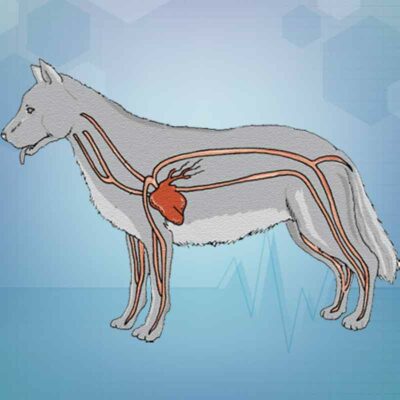 Cardiovascular and circulatory disorders in dogs
Cardiovascular and circulatory disorders in dogs
The canine cardiovascular system, also known as the circulatory system, plays a vital role in distributing blood throughout the dog’s body. Comprising the heart and a network of arteries, veins, and capillaries, it ensures proper blood circulation.
Positioned in the chest cavity amidst the lungs, the heart resides within a delicate pericardial sac, spanning approximately from the 3rd to the 6th rib in a dog.
Blood vessels form an intricate network that spans the body, delivering blood to every organ, tissue, and cell.
This system serves as a conduit, ferrying oxygen, nutrients, immune components, hormones, and essential substances required for normal bodily functions and activities to the body’s tissues and organs. Simultaneously, it removes waste products and carbon dioxide, regulates body temperature, and maintains a healthy balance of water and electrolytes.
1. Heart Disease In Dogs
Situated at the core of the animal’s circulatory system, the heart diligently propels oxygen to each cell throughout the body. In canines, heart diseases fall under the category of internal medicine conditions.
Veterinarians need substantial expertise in identifying and addressing various internal medicine conditions in dogs, encompassing prevalent heart diseases detailed below. If your pet’s treatment exceeds your veterinarian’s expertise, they should guide you to a proficient veterinary internist (specialist in veterinary internal medicine) to guarantee optimal care for your pet.
1.1 Dilated Cardiomyopathy (DCM)
Dilated cardiomyopathy (DCM) is a cardiac condition characterized by the weakening and enlargement of the heart muscle, leading to inadequate blood pumping, often resulting in congestive heart failure.
This ailment predominantly affects middle-aged to older large-breed dogs like Doberman Pinchers, Boxers, Great Danes, and sporadically Cocker Spaniels. Genetic inclinations within these breeds contribute significantly to DCM, with ongoing studies aiming to introduce genetic tests for early detection.
While genetic predisposition is primary, rare instances attribute DCM to factors like taurine deficiencies, certain medications such as doxorubicin, and infections caused by specific viruses or parasites like parvovirus or Chagas disease.
Symptoms of DCM typically manifest in three ways:
- Left heart failure: Indicated by breathing difficulties, exercise intolerance, or coughing due to fluid buildup in the lungs.
- Right heart failure: Presents symptoms like exercise intolerance, abdominal enlargement, or breathing difficulties caused by fluid accumulation in the abdomen or chest.
- Arrhythmias: Progression of DCM can result in abnormal heart rhythms, leading to fainting or sudden collapses, sometimes without prior symptoms.
As there’s no feasibility for heart transplants in dogs, treatment focuses on managing clinical signs. Therapies involve diuretics to alleviate fluid buildup, medications like pimobendan to enhance heart function, and treatments to address arrhythmias.
DCM diagnosis relies on an echocardiogram, assessing heart muscle thickness and contraction strength. Clinical signs, electrocardiogram (ECG) findings, or X-rays indicating an enlarged heart also aid in presumptive diagnoses.
Prevention primarily relies on upcoming genetic tests to enable selective breeding. Apart from taurine deficiencies, nutritional supplements show limited impact on the disease. Administering prescribed medications helps manage symptoms and improve the pet’s comfort and longevity.
While incurable, appropriate medical interventions can significantly extend the affected animal’s quality of life, offering several months to years of improved health.


